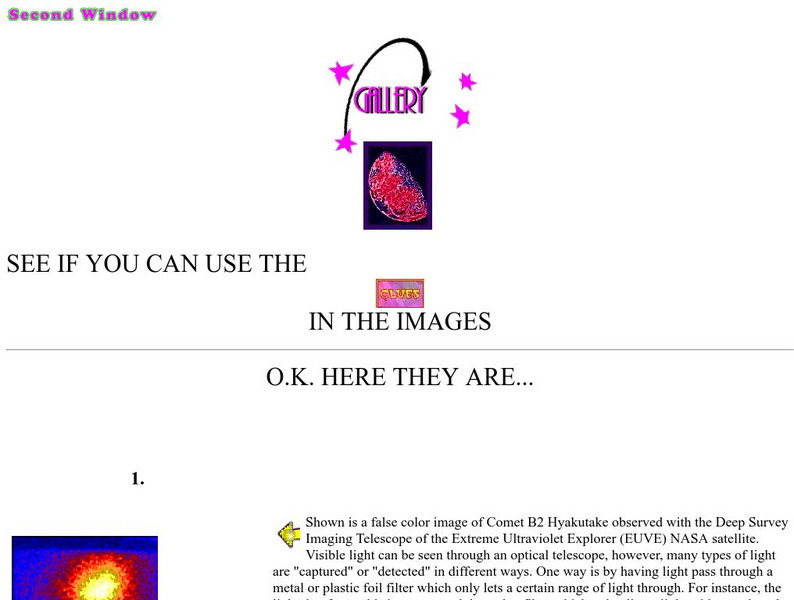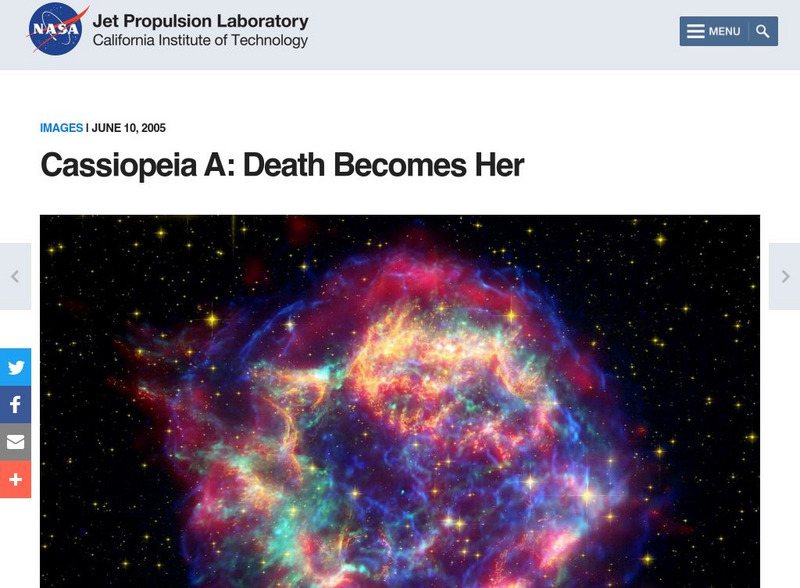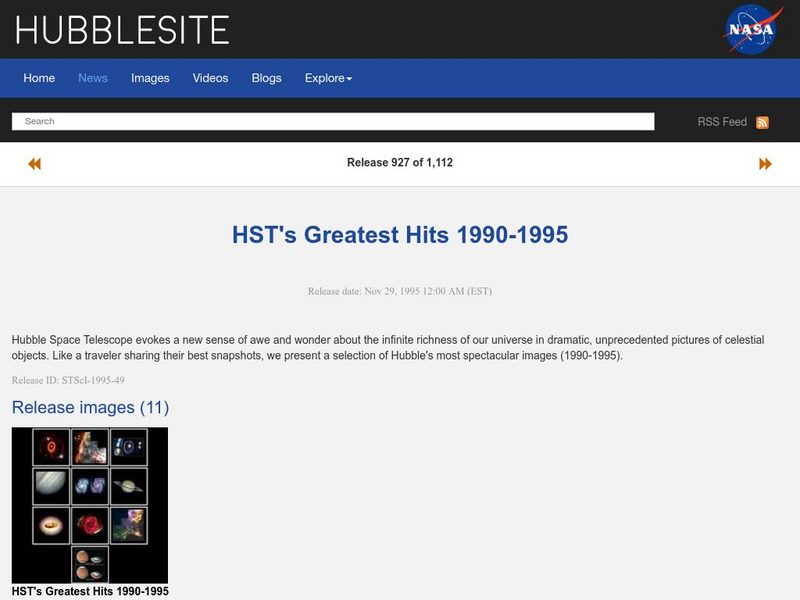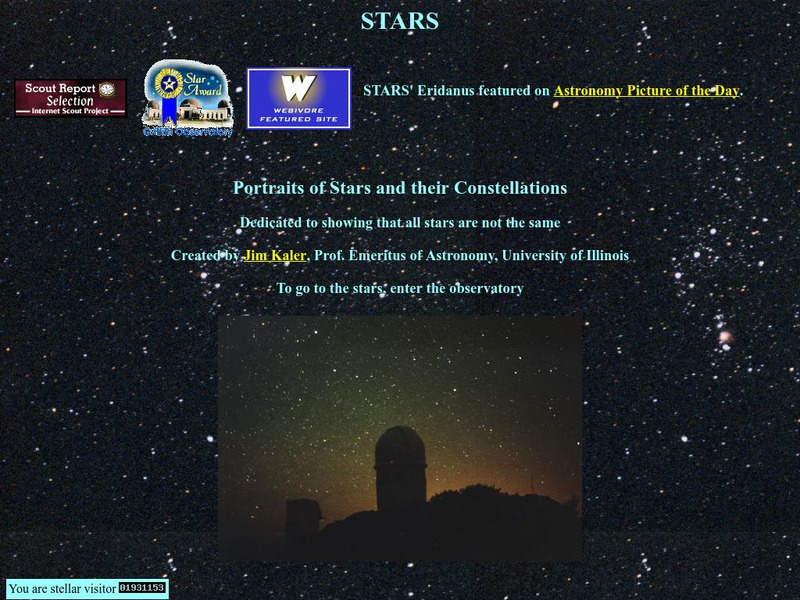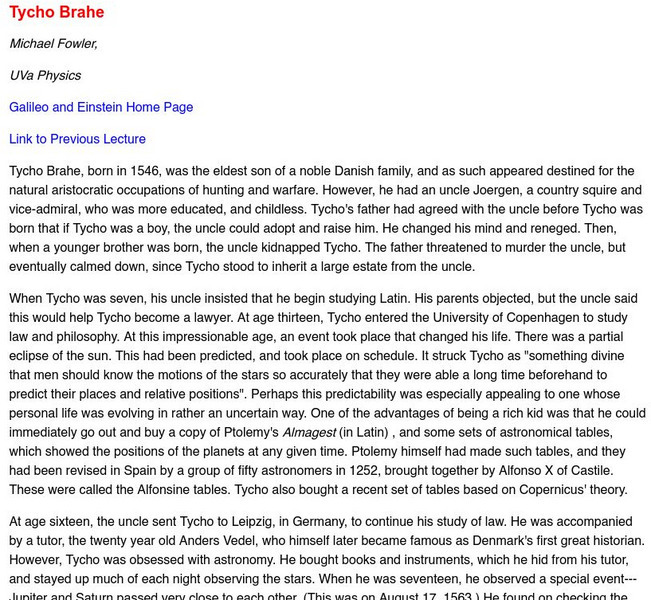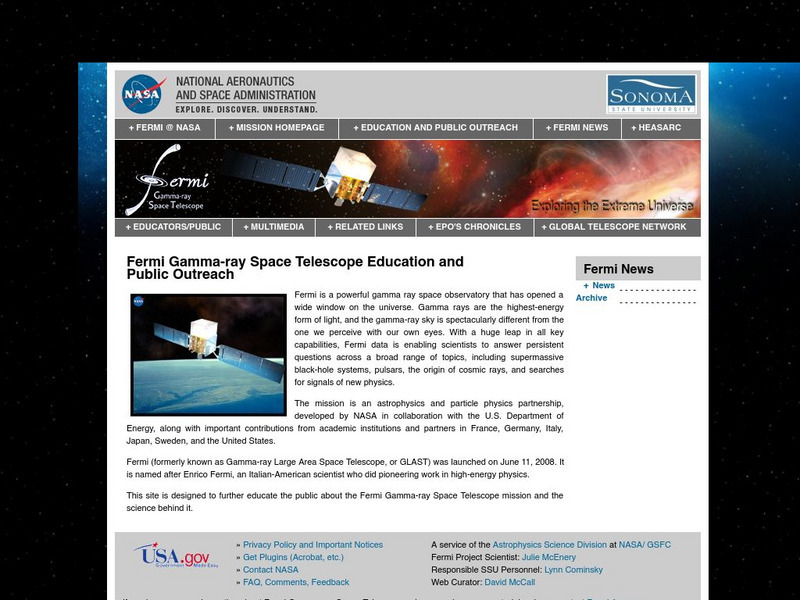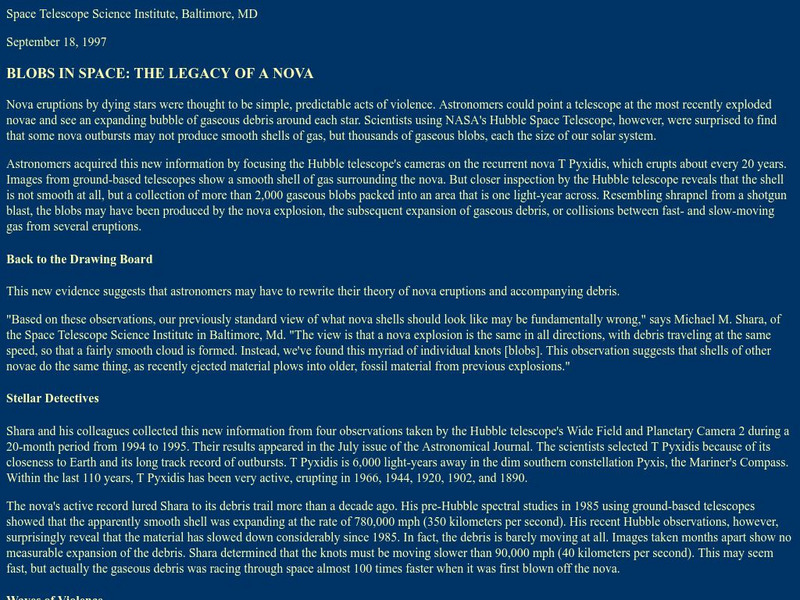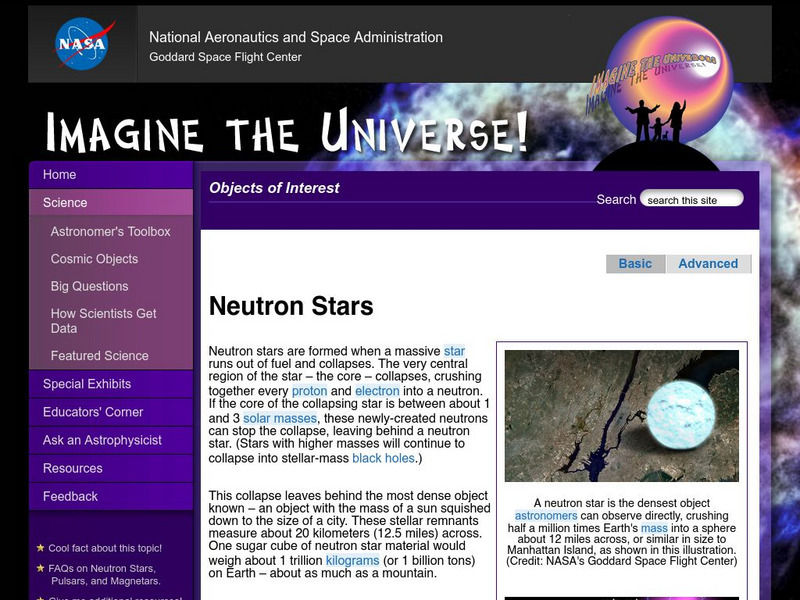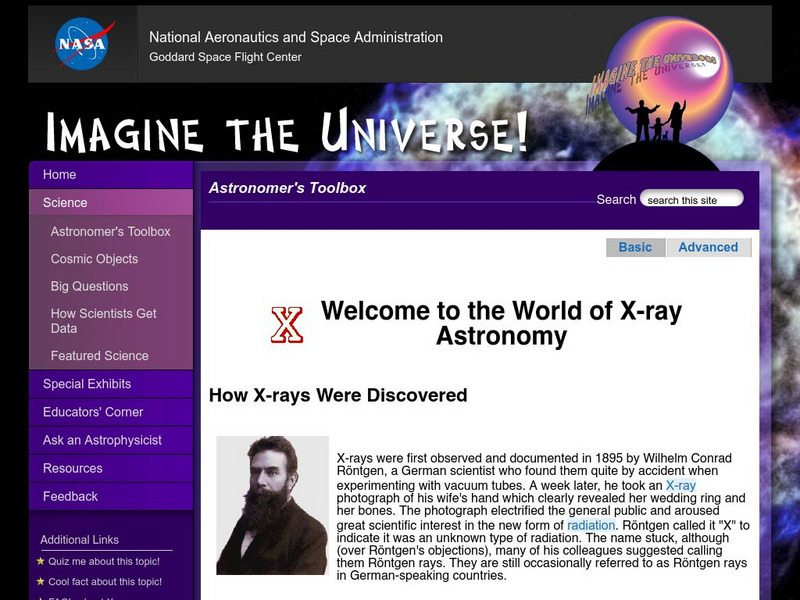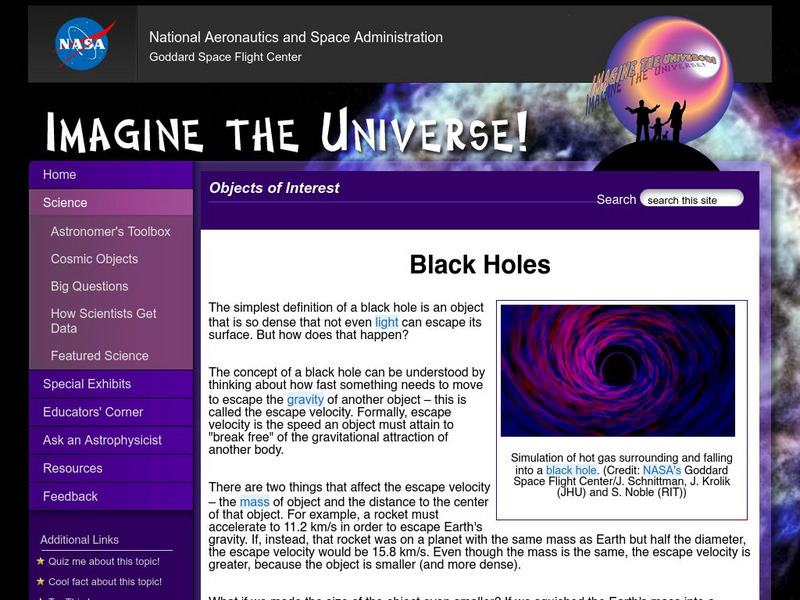University of California
Center for Science Education: Gallery
A gallery of astronomy images which depict galaxies, comets, the moon, planets, nebulae, supernovae as seen in various regions of the electromagnetic spectrum. Each image in the gallery is described. Fascinating!
California Institute of Technology
Spitzer Science Center: Massive Star's Death
Under the heading, "The (Almost) Invisible Aftermath of a Massive Star's Death" this site examines specific details of an image which demonstrates the death of a star that does not end in an impressive supernova but rather fades away.
NASA
Nasa: Cassiopeia A
This image, titled "Cassiopeia A: Death Becomes Her" features the supernova remnants of Cassiopeia A. The text under the image details various specifics about the picture.
Curated OER
Sequence of Events in a Supernova Explosion
The complex sequence of events in a supernova explosion are explained and illustrated.
Massachusetts Institute of Technology
Mit: Open Course Ware: Courses: Physics: Classical Mechanics
College-level online course highlighting the study of classical mechanics. This course focuses on Newtonian mechanics, fluid mechanics, and kinetic gas theory. Course features include a 35 video lecture series by Walter Lewin. Also link...
University of Utah
University of Utah: Aspire: Life Cycle of a Star
Experience this impressive interactive website about the life cycle of a star.
Georgia Department of Education
Ga Virtual Learning: A Brief History of Astronomy
In this interactive module students will explore what different ancient cultures believe was an explanation of the stars and planets. They will look at how the work of Nicolas Copernicus revolutionize the world of astronomy and learn how...
Space Telescope Science Institute
Hubble Space Photographs: Hst's Greatest Hits 1990 1995
Breathtaking images from the Hubble Space Telescope give a new perspective to our world.
PBS
Pbs Teachers:monster of the Milky Way: Birth of a Black Hole
Discover how a dying star can be reborn as a black hole. View a slide show that follows the progression of events from an old, dying star to newborn black hole.
PBS
Pbs Learning Media: Pulsars: Little Green Men
The story behind Jocelyn Bell's role in the discovery of pulsars is told in this colorful, comic-book-style resource from A Science Odyssey Web site.
PBS
Pbs Learning Media: How Big Is the Universe?
In this media-rich essay from the NOVA Web site, astronomer Brent Tully of the University of Hawaii walks you through the latest scientific theories about the size of the universe.
TED Talks
Ted: Ted Ed: Where Does Gold Come From?
Did you know that gold is extraterrestrial? Instead of arising from our planet's rocky crust, it was actually cooked up in space and is present on Earth because of cataclysmic stellar explosions called supernovae. CERN Scientist David...
Utah Education Network
Uen: Where Did the Matter in the Universe Come From?
Students use various articles about how atoms are made and spread throughout the universe starting with the Big Bang. They will study the articles as groups and will then present their information to the class.
University of Illinois
University of Illinois: Stars and Constellations
A large collection of information about and photos of the starts and constellations in the sky.
University of Virginia
Tycho Brahe U Va Physics
This site contains information about Tycho Brahe's life as well as his accomplishments.
California Institute of Technology
Spitzer Science Center: Where Galactic Snakes Live
Following the title, "Where Galactic Snakes Live" this site examines an image of "Galactic Snakes" which are actually clouds larger than several solar systems. The text below the image proceeds to explain certain stellar features...
Wikimedia
Wikipedia: Tycho Brahe
A great overview of the life of astronomer Tycho Brahe from Wikipedia Encyclopedia. This article discusses his contributions to the world of astronomy, and his building of his observatory called Uraniborg.
Sonoma State University
The Gamma Ray Large Area Space Telescope (Glast)
Background information on gamma rays and the sources of gamma rays in the universe. Discusses the purpose of the GLAST space mission and the types of findings which they wish to make. A link to the GLAST movie provides an excellent...
Other
Astronet: Blobs in Space: The Legacy of a Nova
The expansion and explosion of a star is described at it goes through its nova phase. Current theories are discussed.
Space Telescope Science Institute
Nasa: Hubble Space Telescope: Stars
At this site from the HubbleSite you can learn all about a star's life, birth, and death. Site contains links to a star movie as well as space/time location.
NASA
Nasa: Imagine the Universe: Neutron Stars and Pulsars
Discover what neutron stars and pulsars are and view pictures of them. Includes links to additional resources and lesson plans.
NASA
Nasa: Imagine the Universe: Welcome to the World of X Ray Astronomy
Site recounts how X-rays were discovered as well as who discovered them. Offers graphics, links to facts on this topic, a quiz, and teacher resources.
NASA
Nasa: Imagine the Universe: Black Holes
Learn what black holes are and the myths that surround them.
NASA
Nasa: Imagine the Universe: The History of Gamma Ray Astronomy
This NASA article discusses the history of gamma-ray astronomy. Related resources.
Other popular searches
- Star Life Cycle Supernova
- Supernova Remnants
- The Supernova
- Supernova Explosions
- Supernova and Stars
- Supernova Activities
- Supernova Geometry
- The Supernova Geometry


